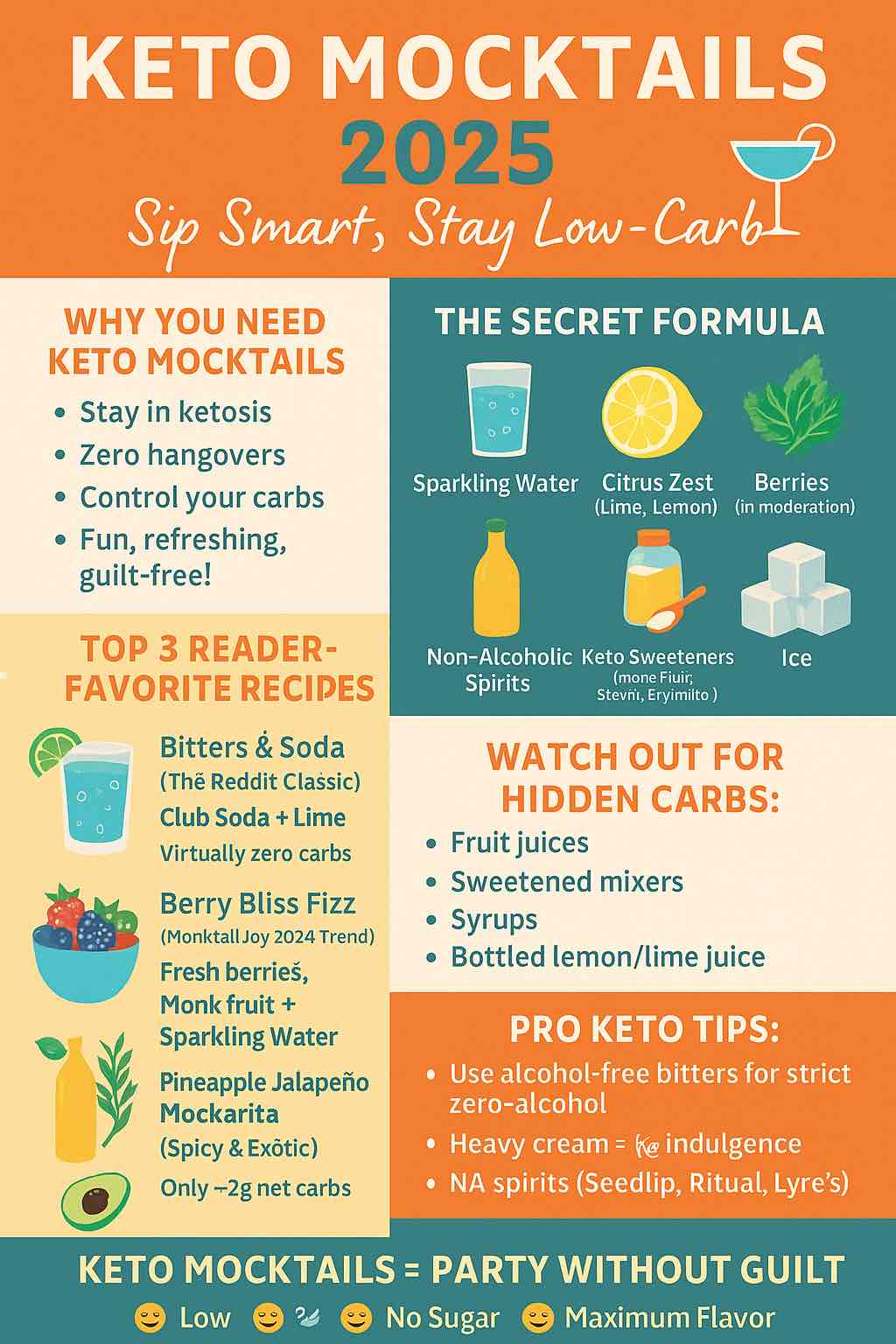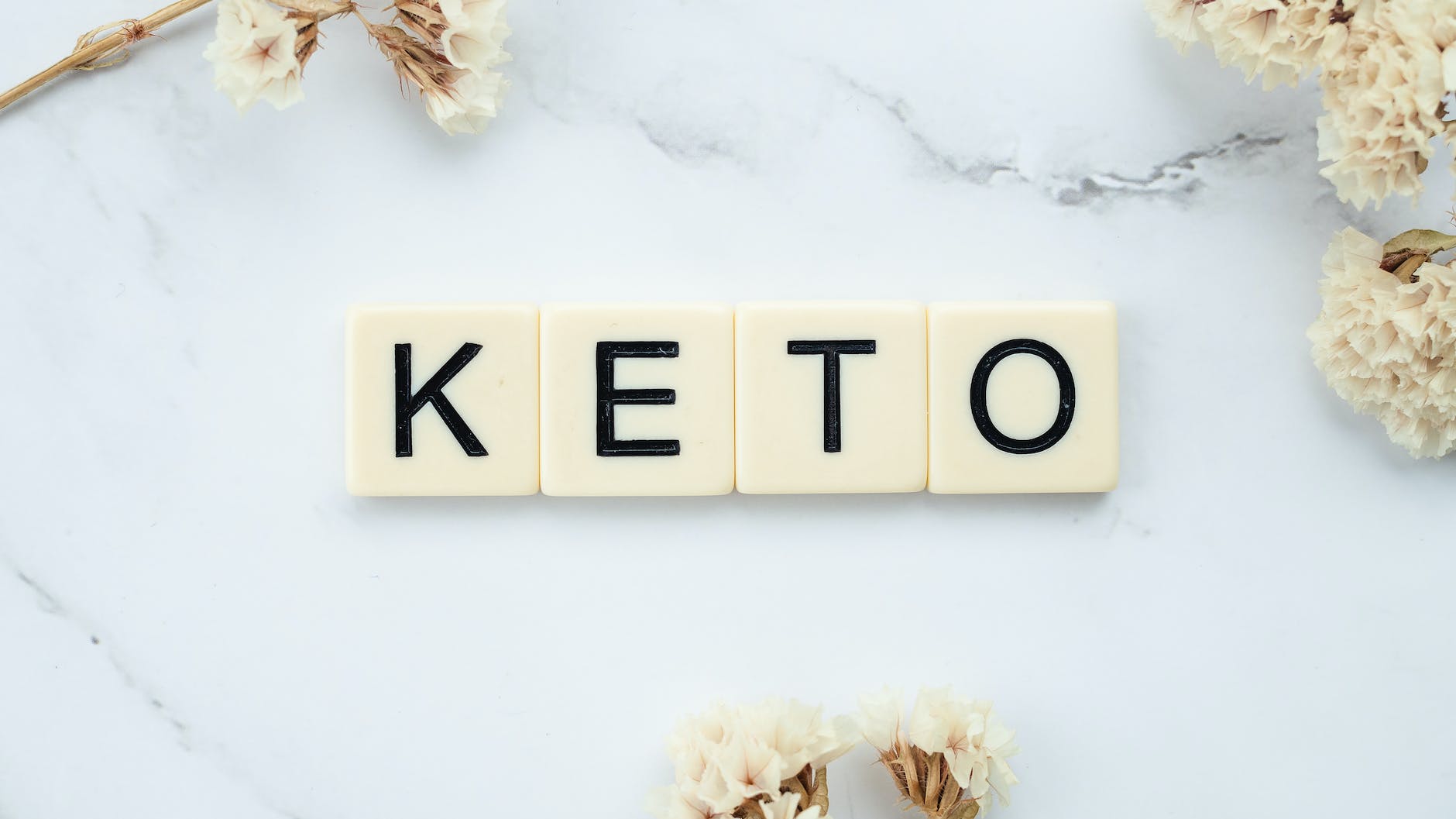
Living the keto lifestyle doesn’t mean you have to give up on happy hours, weekend refreshers, or festive toasts. While traditional cocktails often come loaded with sugary mixers, juices, and syrups, keto mocktails offer creative ways to enjoy delicious, refreshing beverages without compromising your carb count.
In this updated 2025 guide, we dive deep into over 15 keto-friendly mocktails that are practical, easy to make, and packed with flavor. From Reddit-approved community hacks to the latest non-alcoholic spirit trends, this is your ultimate go-to resource for keto mocktails.
🔬 Keto Mocktail Basics: What to Know Before You Mix
Before jumping into recipes, let’s cover the building blocks of keto-friendly non-alcoholic low carb drinks drinks:
| Category | Keto-Friendly Options | Notes |
|---|---|---|
| Sweeteners | Stevia, monk fruit, erythritol, allulose | Avoid sugar, honey, syrups |
| Mixers | Sparkling water, club soda, diet tonic | Watch for hidden sugars |
| Juices | Lemon, lime, tiny amounts of cranberry | Limit portion sizes |
| Fruits | Berries (raspberries, strawberries) | Use sparingly |
| Herbs & Spices | Mint, basil, ginger, rosemary | Flavor enhancers |
| Bitters | Angostura (minimal use, trace carbs) | Keep under 5 drops |
| NA Spirits | Alcohol-free gin, tequila, vodka | More brands available in 2025 |
| Dairy (for creamy) | Heavy cream, coconut cream, almond milk | Watch added sugars |
🥂 The Recipes
1️⃣ Classic Bitters & Soda
The ultimate Reddit-approved, minimalist keto low carb non alcoholic mocktail.
Ingredients:
- 1 glass club soda or sparkling water
- 2–5 dashes Angostura bitters
- 1 lime wedge
- Ice
Instructions:
- Fill your glass with ice.
- Add sparkling water.
- Dash bitters over.
- Garnish with lime.
Pro Tip: Keep bitters minimal to stay under 0.5g carbs.
2️⃣ Zero Sugar Mojito
A refreshing, guilt-free classic of low carb non alcoholic drink for keto.
Ingredients:
- Handful of fresh mint leaves
- Juice of 1/2 lime
- 1 tbsp erythritol or monk fruit sweetener
- 200 ml sparkling water
- Ice
Instructions:
- Muddle mint leaves with lime juice and sweetener.
- Add ice, top with sparkling water.
- Stir gently and garnish with mint.
3️⃣ Berry Bliss Fizz (MocktailJoy, 2024 Trend)
Beautifully vibrant and keto-friendly. This low carb non alcoholic drink is a pure joy.
Ingredients:
- ¼ cup fresh raspberries or blackberries
- 1 tbsp monk fruit sweetener
- 200 ml flavored sparkling water (lemon, lime, or berry)
- Ice
Instructions:
- Muddle berries with sweetener.
- Fill glass with ice and sparkling water.
- Stir well; strain if you want a smoother drink.
4️⃣ Pineapple Jalapeño Mockarita (Reddit Favorite)
Sweet, spicy, and exotic. This keto friendly low carb non alcoholic drink works like a chart. Just have to be careful about the natural sugar that might come from Pineapple.
Ingredients:
- 1 tbsp pineapple extract (sugar-free)
- 2–3 slices fresh jalapeño
- Juice of 1 lime
- 200 ml sparkling water
- Ice
Instructions:
- Muddle jalapeño with lime juice.
- Add pineapple extract and ice.
- Top with sparkling water and garnish with jalapeño.
5️⃣ The Millionaire Sour
Inspired by PersonalTrainerFood’s keto twist. You will love this low carb non alcoholic keto friendly mocktail, just be mindful of the Gingerale that goes into this drink.
Ingredients:
- 200 ml diet ginger ale
- 1 tbsp sugar-free cherry syrup
- Juice of ½ lemon
- Ice
Instructions:
- Combine all ingredients over ice.
- Stir well and serve.
6️⃣ Hibiscus Sunset Sparkler (AP News 2024 Seasonal Hit)
Great for winter parties. This is made low carb by use of Zero Calorie sweetener, turning it into a delicious non alcoholic mocktail.
Ingredients:
- ½ cup brewed hibiscus tea (chilled)
- 100 ml sparkling water
- 1 cinnamon stick
- 2 slices ginger
- 1 slice orange
- Sweetener to taste
Instructions:
- Combine tea, spices, and sweetener.
- Chill, strain, and serve with sparkling water and orange garnish.
7️⃣ Zero Sugar Paloma
Crisp and citrusy. Just be mindful of the natural or added sugar in Grapefruit juice while making this low carb non alcoholic drink recipe.
Ingredients:
- 100 ml fresh grapefruit juice (small portion)
- Juice of ½ lime
- 200 ml diet tonic water
- 1 tbsp erythritol
Instructions:
- Mix juices and sweetener.
- Top with tonic water and serve on ice.
Pro Tip: Grapefruit juice contains carbs—limit portion size.
8️⃣ Oolong Fizz (Reddit Minimalist)
This low carb non alcoholic recipe is for tea lovers. Perfect Keto Mocktail recipe.
Ingredients:
- ½ cup cold-brewed oolong tea
- 200 ml sparkling water
- Juice of ½ lime
- Sweetener to taste
Instructions:
- Mix and serve over ice.
- Garnish with mint or citrus peel.
9️⃣ Sparkling ICE & Cream “Dessert”
Low-carb indulgence. Fantastic low carb non alcoholic recipe.
Ingredients:
- 1 bottle Sparkling ICE (Pineapple Coconut)
- 2 tbsp heavy cream
Instructions:
- Pour Sparkling ICE into glass.
- Slowly stir in heavy cream.
- Serve cold like a keto float.
🔟 Zero-Alcohol Gin & Tonic
Perfect for cocktail hour feel without breaking keto. This low carb non alcoholic recipe can be little complicated, if you are not able to score the right ingredients.
Ingredients:
- 50 ml alcohol-free gin (like Seedlip or Ritual)
- 150 ml diet tonic water
- Lime wedge
Instructions:
- Build over ice.
- Stir gently and garnish.
🔄 Advanced Keto Mocktail Hacks
- ✅ Use ice creatively: Crushed ice, clear cubes, and frozen berries boost presentation.
- ✅ Salted rims: Add a professional touch to margarita-style drinks.
- ✅ Infuse your water: Cucumber, ginger, mint, and herbs add depth.
- ✅ Bitters discipline: Limit to 5 drops unless fully non-alcoholic bitters are used.
- ✅ Tea as mixer: Rooibos, hibiscus, oolong, and green teas work wonderfully.
🚫 Hidden Carbs to Watch For
- Bottled lemon or lime juice often contains added sugar.
- Some flavored sparkling waters sneak in sweeteners.
- NA “mocktail mixers” may still contain up to 10g sugar/serving.
- Always read labels carefully.
🛒 Essential Keto Mocktail Pantry (Shopping List)
- Monk fruit or erythritol sweetener
- Sparkling water, club soda, or diet tonic
- Zero-sugar juices (Ocean Spray 5-cal cranberry)
- Fresh mint, limes, lemons, cucumbers
- Bitters (use sparingly)
- Alcohol-free gin, tequila or vodka (Ritual, Seedlip, Lyre’s)
- Sugar-free syrups (Jordan’s Skinny Syrups)
- Herbal teas (hibiscus, oolong, rooibos)
- Fresh berries (in moderation)
🎉 Final Thoughts: Celebrate, Stay Keto, Feel Good
The world of keto mocktails has evolved rapidly with exciting new ingredients, NA spirits, Reddit wisdom, and creative hacks. Whether you’re hosting a summer barbecue, winding down after work, or celebrating the holidays, these mocktails help you stay in ketosis while still enjoying the art of a good drink.
Bookmark this guide, experiment with flavors, and make your keto lifestyle vibrant and festive.
MasalaMonk will continue to update this guide as more keto innovations hit the world of mixology. Cheers to your health!
📌 Frequently Asked Questions (FAQ)
1️⃣ Are keto mocktails completely alcohol-free?
Most keto mocktails are alcohol-free. However, some recipes use small amounts of bitters, which may contain trace alcohol (usually less than 1% when diluted). If you’re strictly avoiding alcohol, look for non-alcoholic bitters or omit them entirely.
2️⃣ Which sweeteners are best for keto mocktails?
The safest sweeteners for keto are:
- Stevia
- Monk fruit extract
- Erythritol
- Allulose
Avoid sugar, honey, agave, and regular syrups, as they contain too many carbs.
3️⃣ Can I use regular fruit juice in keto mocktails?
Fruit juices are high in natural sugars, so use them sparingly. Stick to:
- Small amounts of lemon or lime juice.
- A splash (1–2 tbsp) of unsweetened cranberry juice.
- Sugar-free juice alternatives whenever possible.
4️⃣ Are bitters safe on keto?
In small amounts (2–5 dashes per drink), bitters contribute negligible carbs. However, excessive use may add minor sugars and alcohol. Always check the label, and if needed, opt for alcohol-free bitters.
5️⃣ What are the best non-alcoholic spirits for keto mocktails?
Top keto-friendly NA spirit brands include:
- Seedlip (multiple varieties)
- Ritual Zero Proof
- Lyre’s
- Monday Gin
Always confirm carb content, but most NA spirits contain little to no sugar.
6️⃣ Can I make creamy keto mocktails?
Yes! Use keto-friendly cream options such as:
- Heavy cream (lowest carbs)
- Coconut cream (unsweetened)
- Almond milk (unsweetened)
Avoid sweetened versions to maintain low carb counts.
7️⃣ How many carbs are in a typical keto mocktail?
Most keto mocktails (if prepared correctly) contain 0–3g net carbs per serving. Carbs primarily come from small amounts of fruit, juice, or cream, so ingredient control is key.
8️⃣ Are flavored sparkling waters keto-approved?
Many are. Stick to brands like:
- LaCroix
- Perrier
- Spindrift (verify the label for fruit juice content)
- Bubly
Avoid any flavored water that lists sugar, sucrose, or glucose in the ingredients.
9️⃣ What fresh ingredients work well in keto mocktails?
Popular keto-friendly fresh ingredients:
- Mint, basil, rosemary
- Lime, lemon (in moderation)
- Fresh berries (small amounts)
- Ginger slices
- Cucumber
These add flavor, aroma, and visual appeal without spiking carbs.
🔟 Can I batch prepare keto mocktails for parties?
Absolutely. Many recipes can be scaled up:
- Mix juices, sweeteners, and flavorings in advance.
- Add sparkling components and ice right before serving.
- Store herbs and garnishes separately for freshness.











